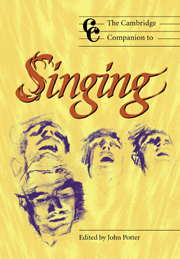Book contents
- Frontmatter
- 1 Introduction: singing at the turn of the century
- Part I Popular traditions
- 2 ‘Songlines’: vocal traditions in world music
- 3 Rock singing
- 4 The evolving language of rap
- 5 Jazz singing: the first hundred years
- Part II The voice in the theatre
- Part III Choral music and song
- Part IV Performance practices
- Notes
- Select bibliography
- Index
2 - ‘Songlines’: vocal traditions in world music
from Part I - Popular traditions
Published online by Cambridge University Press: 28 September 2011
- Frontmatter
- 1 Introduction: singing at the turn of the century
- Part I Popular traditions
- 2 ‘Songlines’: vocal traditions in world music
- 3 Rock singing
- 4 The evolving language of rap
- 5 Jazz singing: the first hundred years
- Part II The voice in the theatre
- Part III Choral music and song
- Part IV Performance practices
- Notes
- Select bibliography
- Index
Summary
Ten years ago, the death of a Pakistani singer, no matter how talented, would have gone unnoticed by most of the world. But when Nusrat Fateh Ali Khan (see Fig. 1) died in August 1997, at the age of forty-eight, even America's notoriously parochial television news programs carried the story. Khan was not just one of the world's greatest singers, he was emblematic of a startling rise of interest in non-Western music, especially within the last quarter of the twentieth century. The late Pakistani singer, along with such world-wide sensations as Youssou N'Dour of Senegal and the globe-trotting choirs of Tibet and Bulgaria, came to represent a musical genre known by the informal and somewhat loosely defined term ‘world music’. This chapter provides an armchair traveller's guide to the world's increasingly miscegenated music. Nusrat Fateh Ali Khan, for example, was a master of the infectious, rhythmically charged Sufi devotional music known as qawwali. Lionised by such rock musicians as Peter Gabriel, The Who's Pete Townsend, and Pearl Jam singer Eddie Vedder, he also proved himself a thoroughly modern fellow, eagerly embracing his unexpected musical allies and moulding their Western pop styles to suit his own needs.
While it was probably an unintended result of the twentieth-century revolution in communications technology, with hindsight it seems unavoidable that people in the West would find themselves, for the first time since the Crusades, becoming keenly aware of non-Western systems of music and singing. ModernWestern listeners have had the unique experience of hearing their own popular music styles refracted through the prism of a hundred different cultures and returning as a brood of musical changelings – for example, in the form of African or Asian cross-cultural pop. And, of course, listeners in contemporary America or Europe have had the opportunity to hear live performances and recordings by some of the greatest singers in the classical, folk and popular styles of the world.
- Type
- Chapter
- Information
- The Cambridge Companion to Singing , pp. 7 - 27Publisher: Cambridge University PressPrint publication year: 2000

